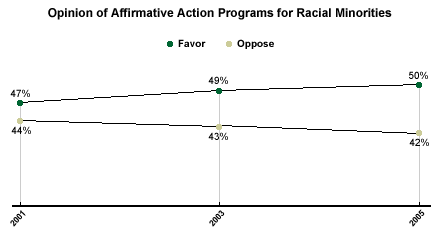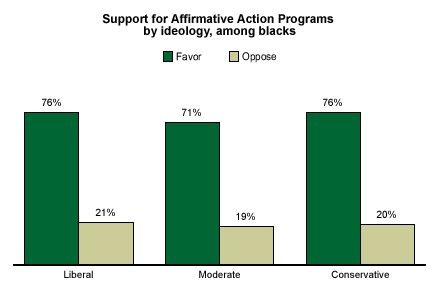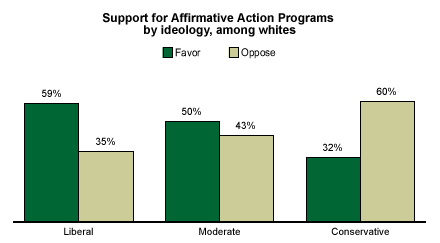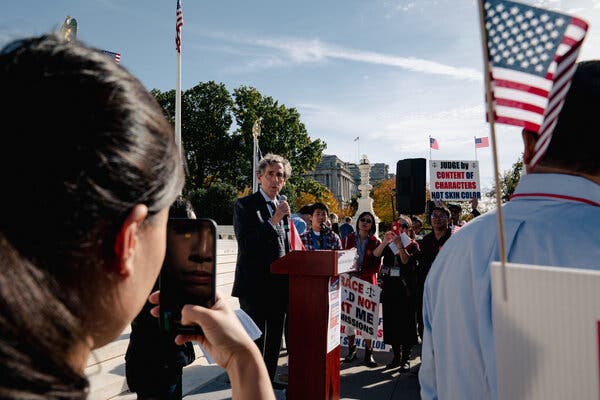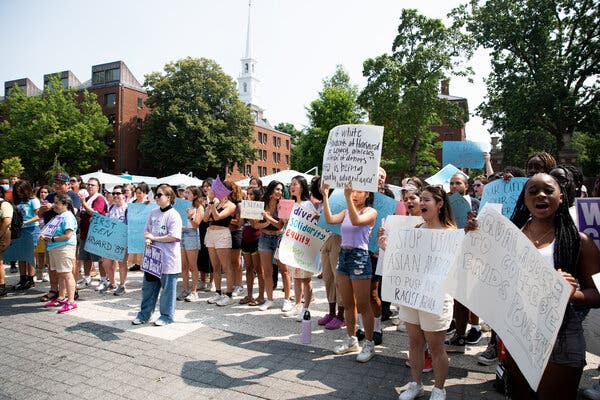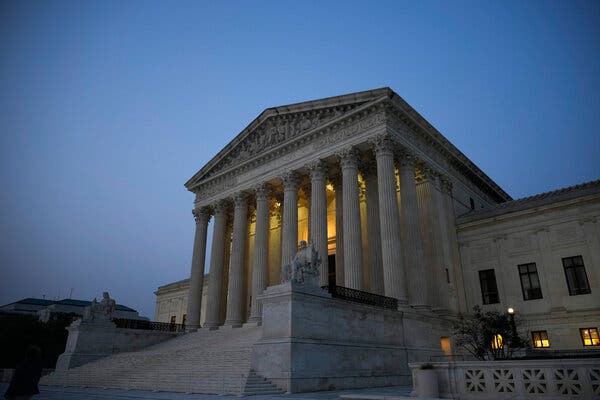He Worked for Years to Overturn Affirmative Action and Finally Won. He’s Not Done.
Edward Blum’s latest victory at the Supreme Court is the culmination of a long fight to take race out of college admissions. Is the workplace next?
Edward Blum calls himself a “matchmaker,” finding plaintiffs and pairing them with lawyers in an effort to remove race-conscious policies from American life.Credit...Jonathan Ernst/Reuters

By
Lulu Garcia-Navarro
July 8, 2023, 5:00 a.m. ET
Edward Blum has been working toward the end of race-based admissions in higher education for years. He first brought the issue of affirmative action before the Supreme Court in 2012, with Fisher v. University of Texas — a case he ended up losing. Since then, the 71-year-old legal activist has founded a group called Students for Fair Admissions, which just won at the Supreme Court against Harvard and the University of North Carolina, in a
decision that effectively ended race-based affirmative action policies in American college admissions.
Now, with a legal victory in hand, Mr. Blum is thinking about what’s next in his work to remove the consideration of race from other parts of American life and law. In a wide-ranging discussion, he told me about how he’ll be watching to make sure elite institutions of higher learning abide by the court’s recent decision, and why he thinks corporate America will be facing scrutiny next. This interview has been condensed and edited for length and clarity.
How are you feeling about your victory, Edward? How did you celebrate?
Well, there wasn’t a six-hour rock ’n’ roll party between myself and the lawyers. We got together rather early and split up rather early. I went back to my hotel room, spoke to my wife at length, answered some emails, drank another glass of wine, took an Ambien and went to bed.
For people who don’t know your work, you’ve filed over two dozen cases since the 1990s attempting to remove the concept of race from America’s laws, eight of which have made it to the Supreme Court, which is a lot.
In addition to this big affirmative action case, you were also behind the landmark voting rights case in 2013, Shelby County v. Holder, which overturned a key provision of the Voting Rights Act. How do you describe the work you do?
Well, I think there’s two parts to my answer. The first is the technical part. I see myself as something of a Yente the matchmaker — I’ve used that expression in the past — that character from “Fiddler on the Roof.” I seek out individuals or jurisdictions, corporations who have been discriminated against in various endeavors because of their race and ethnicity. Over the years, my outreach has diminished because I guess I’m a more high-profile individual and people contact me. I pair them with lawyers. Then if the lawyers believe that there is a cause of action, I go out and try to raise money to pay for the lawyers.
Now, philosophically, there’s a common theme in all of this. Like the vast majority of Americans, I believe that an individual’s race and ethnicity should not be used to help them or harm them in their life’s endeavors. And those life’s endeavors include, you know, if they’re gerrymandered into a voting district because they’re a certain race, if they’re applying for a job that they’re not going to get because they’re a certain race or they’re applying to a college or university that they won’t be admitted to because of their race or ethnicity.
I want to understand a little bit about what that matchmaking work looks like day to day. I read that you wake up every morning and scour local papers for cases.
My day begins awfully early. I live in Maine six months out of the year. Even if I would like to sleep longer, I live in an area that’s described as working waterfront, so at around 4:30 every morning, diesel engines are fired up from the lobster boats that surround this little part of my community, and they’re quite loud. So I’m up at 4:30. And I am an inveterate newspaper reader. Now that things are online, it’s very easy to look around newspaper articles, press releases, the internet, in which policies are described, new rules and regulations are described. And I kind of noodle my way through that for about three hours looking around for misdeeds by various actors who are discriminating on the basis of race.
I know you were raised in a liberal Jewish family. What made you break from the way that you had been brought up?
I don’t think I broke at all from the way I was brought up. I was brought up in a liberal Jewish household. My mother and father spoke Yiddish. I was a teenager during the civil rights movement. The idea of treating people equally, not being a racist, not being a bigot, was a conversation at my dinner table. My father and mother knew antisemitism.
It’s easy to characterize someone like me, who is against racial preferences and classifications, as someone who has broken with standard Jewish philosophy and Jewish heritage. I disagree with that. I think the vast majority of Americans, in poll after poll, Jews, gentiles, African Americans, Hispanics, don’t believe that a student’s race should be an element in college admissions.
But it does depend on the way the question is asked. It does depend to whom the question is asked. But back to the original point of your upbringing: You don’t feel you broke with that.
Well, the good thing about what I do is I am focused on one area of public policy, and that is race and ethnicity. You should know — I’m not going to go into detail — that I have center-left opinions about many policy issues in this country. I have center-right opinions about other public policy and foreign policy issues in this country. If you held a dagger to my throat and said, “Tell us what you believe in that center left” —
I won’t.
I would tell you there’s lots of things that would surprise people, but it’s less important what I believe about the environment, the death penalty, abortion, property rights. That’s not important. That’s not the focus of what I do, nor should it be. You can call me a conservative Republican, and I’m not going to argue with that, but if I were to lay out all the things that would put me in the camp of Hubert Humphrey, you might be surprised, Lulu.
I want to talk about last week’s decision. Harvard was at the center of the case. The Harvard class of 1963 had 18 Black students. Now, in the most recently admitted class, the class of 2027, more than 15 percent of the students are Black, 11 percent of the students are Latino, and nearly 30 percent are Asian American, which is, by the way, a record proportion of Asian American students for the college. Affirmative action, many would argue, has not been perfect, but those numbers also tell a story: that taking race into consideration has led to a dramatically more diverse student body, no?
Well, let me back up a little bit and talk about the growth in the Asian acceptance rates, because this is something that we’ve briefed in court.
In 2014, the year we sued Harvard, the Asian admissions rate was, I think, around 18, maybe 19 percent. During the last eight years, the admissions rates at Harvard for Asians have grown from about 18 percent now up to 30 percent. Yet if you look back from 2014, all the way back to about 1999, it was flatlined for 20 years. But then when Harvard gets sued, all of a sudden the number of Asians go up by 60 percent. How is that possible? How did that happen? Well, I think the numbers speak for themselves. [Harvard has attributed the growth to a steady increase in applications in recent years across all racial categories.]
But let me go back to your other question. Can the bar be raised for some kids, based upon their ethnicity and their race, and lowered for others, in order to create a diverse campus? The law does not permit that in any area of our public policy. There is no way to increase the percentage of Black and Latino students without decreasing the percentage of Asian American and white students.
Racial classifications is a zero-sum game. There are better ways to achieve individualized student diversity than treating students differently by race and ethnicity.
Mr. Blum will be watching to see how universities like Harvard and the University of North Carolina adjust their admissions policies, but he said, “I am not at war with higher education.”Credit...Shuran Huang for The New York Times
We’ll get to what those might be, but I want to just ask you here, because what those numbers show is that affirmative action actually had an effect, regardless of whether you think it’s a zero-sum game or not. If the goal is to admit a wider array of different types of students, it measurably did do that.
Most people who talk about diversity — and I think this is where your question is leading — most people who talk about diversity are really talking about skin color diversity. How somebody looks. What’s your skin color? What’s the shape of your eyes? What’s the texture of your hair?
Most Americans don’t think that the shape of your eyes tells us much about who you are as an individual. What does your skin color tell the world about who you are as an individual? If the argument is your skin color tells us a lot —
Perhaps that you might have similar experiences?
No, it doesn’t. It doesn’t at all. If you look at the record that we provided the court, an African American growing up on West 145th Street in New York City is going to be a very different person than an African American growing up in a multiracial suburb of Atlanta, whose father is a dermatologist and her mother is the principal of a high school. All that those two people probably have in common is that they have similar skin colors. They’re not interchangeable just because they’re Black.
You’re talking about class, but I’d rather not conflate things because there are correlations between class and race, but it isn’t the same thing. You can be rich and Black and be discriminated against. It doesn’t have to be an either-or. And I would like to understand a little bit about how you view race. Do you see anti-Black racism as different from other kinds of discrimination because of America’s history of slavery, Jim Crow, redlining?
It’s unique. It would be foolish of anyone to say that the experience of African Americans in the United States is not unique in the American experience. But you cannot remedy past discrimination with new discrimination. You cannot remedy the preferences that whites had in our nation’s life with different preferences for different ethnic groups. That cannot be how a multiracial, multiethnic nation maintains its social fabric.
Look, there is bigotry today, there is discrimination today in the United States, there is antisemitism in the United States, there is homophobia in the United States. There’s all those things in Belgium and in Venezuela and in Russia and in China. Bigotry, antisemitism, homophobia is a human disease. It cannot be cured. It can be fought, but it cannot be cured, and trying to cure it with new discrimination only makes the situation worse.
I am wondering if you believe in systemic racism — racism embedded in the institutions of American life. Because if you look at statistics in this country, a typical white family holds 10 times the wealth that a typical Black family does. There are currently only eight Black CEOs of Fortune 500 companies, 20 Latino CEOs. Black people live sicker lives and they die younger than white people. I could go on.
No, I do not believe in it. What your question implies is that in the American DNA there is racism. It was founded upon racism. It is part of what this country is. I reject that.
What do you see as the right formula for fairness in creating a diverse student body? You say that race shouldn’t matter, but you do concede, and I’ve heard you say this in other interviews, that racial diversity is a laudable goal.
So, let me give a couple of examples about the importance of students being around people who look different from them.
In the state of Georgia, Spelman College is a historic Black college and university, an H.B.C.U. It has no diversity. And by that I mean that all the students at Spelman are women. All of the students at Spelman are African American. It is 99 percent African American. There are probably no Asians, maybe one or two whites, a handful of Hispanics, but 99 or 98 percent African American. Spelman gets 10,000 applications every year. These are African American women that want to go to this college knowing that there is no skin color diversity or sex diversity at their college. This is where they want to go.
H.B.C.U.s like Spelman were created to address racism and exclusion in higher education. But, OK, I suppose we don’t have to mandate that schools be diverse, but for schools that want to be diverse, like Harvard or others, why make it harder?
I’m not making it harder. Harvard’s making it harder. Harvard has admissions policies in place that we haven’t talked about yet, but this might be a good time to do that. Harvard, as you know, has preferences for legacies — those children whose parents attended Harvard. They have preferences for faculty and staff. They have preferences for what are called minor sports — fencing, water polo, squash. And then of course they have preferences for donors, significant donors.
If Harvard and the rest of these competitive universities eliminated these kinds of preferences and instead cast a wider net to kids who come from disadvantaged backgrounds, kids who attended high schools that don’t send very many students off to college, kids who come from single-parent households, kids who come from households that have very modest incomes, virtually no wealth — cast your net in that direction. End your legacy and donor preferences, and you’re going to have a much more individualized student body than putting a thumb on the scale for some people who look a certain way and putting a different thumb on the scale for people who look another way.
Independent reviews, though, have found that race-neutral policies can’t replicate race-conscious ones.
We’re going to have to work harder then. We cannot discriminate in order to achieve percentage outcomes that are reflected in the population.
As you know, the University of California system eliminated affirmative action, and there was an entire generation of students, Black and brown, that basically missed out on receiving an elite higher education.
Well, that’s California’s fault. The University of Texas, back in the 1990s, was forbidden from using race and ethnicity because of a challenge to the University of Texas’ law school. The Fifth Circuit ruled that no college and university can use race as an element in college admissions.
The year that happened, there was a dramatic drop-off because obviously, racial preferences made a huge difference in the admissions of African Americans and Latinos. But what did the state of Texas do? It passed something called the top 10 percent law, which allowed students who graduated in the top 10 percent of their class, regardless of their SATs, to attend any public university in the state of Texas.
What happened two years after that law went into effect? More racial minorities were in attendance at the University of Texas than there were when race-based affirmative action was in place. So California blew it. Shame on California.
Image
Harvard students and supporters of affirmative action at a July 1 protest against the Supreme Court’s ruling.Credit...Kayana Szymczak for The New York Times
I want to look ahead now because, as I’m sure you would acknowledge, universities aren’t going to stop trying to admit diverse classes. They’ll just have to find new ways to do it. So how will you be evaluating if new policies are simply proxies for race-based affirmative action?
I don’t know yet. It’s going to be, I think, a school-by-school, case-by-case analysis. Some new admissions policies that use socioeconomic measurements are going to be just fine. Some states may pass percentage plans. That’s going to be just fine. Other schools may do something that is a direct proxy for race, and the opinion that came out in these cases has already really sort of put colleges and universities on notice that direct proxies for race are going to be actionable in a court of law.
This points to a larger problem, which is how you know what a direct proxy of race is when you’re trying to evaluate this. The intersection of race and other identities is extremely complex.
It is, and this is something that lawyers and general counsel at universities are starting to think about in great detail. Let me see if I can give an example of something that would be a direct proxy. The shibboleth, the test, for a direct proxy would be if a university adopts a policy that increases the number of racial minorities. Call that University A. But University B in another state takes that same policy and uses it to increase the number of white students and Asian students. Would that then be challengeable? If it’s challengeable if it helps whites and Asians in a state or at a university, then it’s going to be challengeable if it helps African Americans and Latinos in another, different university or college.
I understand this, but I’m still confused as to what you think the metric for this should be.
Lulu, what you’re asking me is how do I know that Harvard’s new admissions policies would cross the line that the Supreme Court just laid out.
We don’t know yet. Harvard hasn’t told us what they’re going to do. Stanford hasn’t told us what they’re going to do. M.I.T. or, you know, the University of Houston, the University of Texas — we don’t know yet. So I can’t really give you a solid answer until we see something.
I’m curious if you feel like this is now a Pandora’s box that has been opened. How can every single university in America that has used affirmative action be monitored in this way?
It’ll be difficult. But I think colleges and universities generally want to comport with the law. They want to make a good-faith effort to cobble together and craft a new admissions policy that is not only legal, but achieves the kinds of diversity goals that they seek.
I am not at war with higher education. Harvard and U.N.C. have been my opponents. They have not been my enemies. There’s a very important passage in a very important book that reminds those who have been successful in battle: You don’t cut down the fruit trees of those you have defeated. Students for Fair Admissions is not out to cut down the fruit trees of Harvard and U.N.C.
We don’t want a bonfire for the Ivy League. That is not what we sought. We’re going to give them every benefit of the doubt and hope that they adhere to this very important Supreme Court opinion. And we’ll just have to see what happens.
Jm
After this decision came down, three minority advocacy groups filed a complaintwith the Department of Education over Harvard’s legacy admissions policy, which overwhelmingly benefits wealthy white applicants, as you’ve noted. What do you think of what they’ve done?
Well, it is doubtful that legacy preferences violate our 1964 Civil Rights Act or our Constitution. If that were the case, I would have expected the N.A.A.C.P., the A.C.L.U., to have brought lawsuits against Harvard and dozens of other colleges and universities challenging legacy admissions policies in federal court. The fact that they have not done that leads me, and I think most legal scholars, to think that this is not going to be fruitful at the Department of Education.
So you think it’ll fail. Do you think it’s a worthy endeavor?
I think it’ll fail. I think it’s a wonderful endeavor. Even if it fails, it holds higher education’s feet to the fire. Let us hear from the presidents of colleges and universities why they are going to continue using legacy preferences in their admissions policies.
OK. Can we talk a little bit about how you’re funded? Because you do get millions of dollars for this work from political groups on the right, and I’m curious if you see yourself as a political actor.
I am the world’s worst fund-raiser. Considering these cases have now been going on for nine years. We’ve never really had a robust, organized fund-raising campaign. Fortunately — fortunately!— there have been a handful of foundations and a handful of high-net-worth individuals and, I should add, now approaching 7,000 individuals who have gone online to make donations to Students for Fair Admissions.
I should also just clarify one thing. The foundations that have supported us are not uniformly considered political right-wing foundations.
The Searle Freedom Trust, the Bradley Foundation, DonorsTrust — I mean, these are prominent conservative funders. So a lot of the money does come from there. And I guess, again, what I’m asking you is do you see yourself as a political actor.
Oh, no. Absolutely not. And by “political,” I’m assuming that you mean there is something about partisan politics here? That there’s something that promotes the Republican Party over the Democrat Party?
Yes.
Um, no.
Image
All right. It’s hard to imagine that this decision won’t open the door to legal challenges to race-conscious policies in other parts of American life. What else might you have your eye on? Race-based contracts, internships specifically for underrepresented groups, D.E.I. programs?
Well, D.E.I. programs are not challengeable, unless those D.E.I. programs involve a racial preference. It is not illegal for a corporation to hire a D.E.I. officer and staff that office with dozens or hundreds of people and compel employees to listen to speeches. That’s not actionable.





